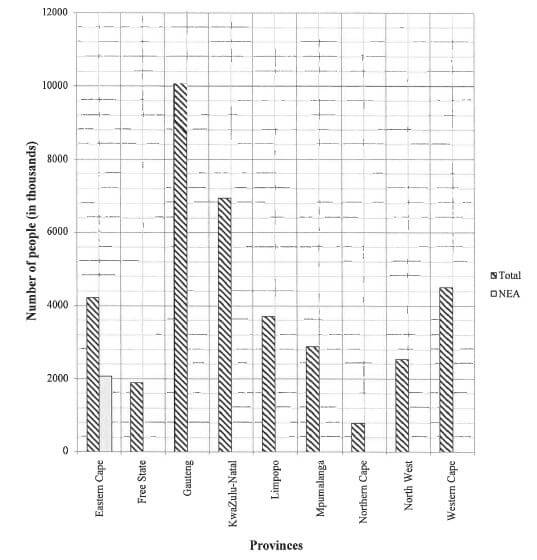MATHEMATICAL LITERACY PAPER 1 GRADE 12 QUESTIONS - NSC EXAMS PAST PAPERS AND MEMOS NOVEMBER 2018
Share via Whatsapp Join our WhatsApp Group Join our Telegram GroupMATHEMATICAL LITERACY
PAPER 1
GRADE 12
NSC EXAMS
PAST PAPERS AND MEMOS NOVEMBER 2018
INSTRUCTIONS AND INFORMATION
- This question paper consists of FIVE questions. Answer ALL the questions.
- 2.1 Use the ANNEXURES in the ADDENDUM to answer the following questions:
- ANNEXURE A for QUESTION 2.1
- ANNEXURE B for QUESTION 3.1
- ANNEXURE C for QUESTION 4
2.2 Answer QUESTION 5.2.7 on the attached ANSWER SHEET.
2.3 Write your centre number and examination number in the spaces on the ANSWER SHEET. Hand in the ANSWER SHEET with your ANSWER BOOK.
- Number the answers correctly according to the numbering system used in this question paper.
- Start EACH question on a NEW page.
- You may use an approved calculator (non-programmable and non-graphical), unless stated otherwise.
- Show ALL calculations clearly.
- Round off ALL final answers appropriately according to the given context, unless stated otherwise.
- Indicate units of measurement, where applicable.
- Maps and diagrams are NOT necessarily drawn to scale, unless stated otherwise.
- Write neatly and legibly.
QUESTIONS
QUESTION 1
1.1 Happy Life Superstore advertised the specials below for the annual Black Friday in 2017.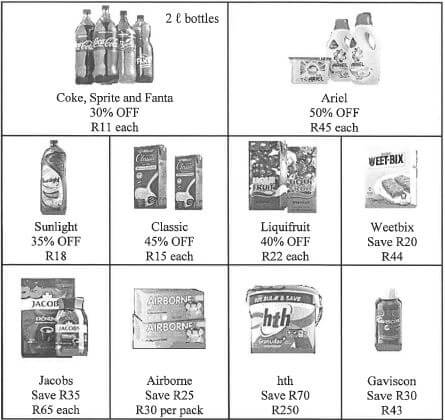
NOTE:
- 1 L =1000ML
- ALL amounts given INCLUDE the discount
Study the advertisement above to answer the questions that follow.
1.1.1 Write down the number of day(s) on which these prices are valid. (2)
1.1.2 Calculate the original price of hth before the saving. (2)
1.1.3 Write down the name of the product which is now half price. (2)
1.1.4 Convert 750 mt to litres. (2)
1.1.5 Calculate the total price of ONE 2 L-bottle of Coca Cola and TWO 2 L-bottles of Fanta. (2)
1.1.6 Arrange ALL the sale prices in ascending order. (2)
1.2 The picture below is a scaled drawing of a T-shirt for Grade 12 learners.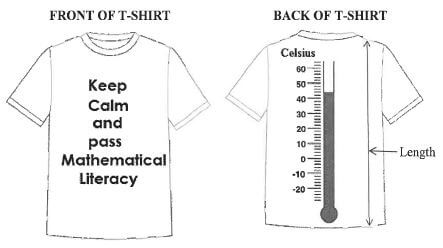
Scale = 1 : 25
1.2.1 Calculate the number of letters needed to print the logo on the front of the T-shirt. (2)
1.2.2 Write down the temperature displayed on the thermometer in 'C. (2)
1.2.3 Explain the meaning of the scale in the drawing above. (2)
1.2.4 Measure the length of the back of the T-shirt in mm, as indicated in the drawing. (2)
1.3 The Two Oceans Marathon and the Comrades Marathon are two of the most popular ultramarathons in the world.
TABLE 1 below shows the dates, distances and entry fees of these marathons.
TABLE 1: TWO OCEANS MARATHON VS COMRADES MARATHON
| TWO OCEANS | COMRADES | |
| Date (2017) | 15 April 2017 | 4 June 2017 |
| Distance | 56 km | 89 km |
| Entry fee | R520,00 | R460,00 |
[Adapted from www.capetownmagazine.com and www.news.comrades.com]
Use TABLE 1 above to answer the questions that follow.
1.3.1 Which race took place first? (2)
1.3.2 Which one of the two races had the longest distance? (2)
1.3.3 Determine the difference between the entrance fee of the Two Oceans Marathon and the entrance fee of the Comrades Marathon. (2)
1.4
The Comrades Marathon Association (CMA) has issued its medical statistics for the
|
[Adapted from http://www.runnersworld.co.za]
Use TABLE 2 above to answer the questions that follow.
1.4.1 Write down the maximum time given to the athletes to complete the Comrades Marathon. (2)
1.4.2 State if the medical statistics data is discrete or continuous. (2)
1.4.3 Write down the ratio of athletes starting the race to the athletes finishing the race. (2) [32]
QUESTION 2
2.1 ANNEXURE A shows the student fees statement for Tamryn Abrahams, a second-year Architecture student at the University of Cape Town (UCT).
Use ANNEXURE A to answer the questions that follow.
2.1.1 Explain the meaning of the term interest with reference to the student fees statement. (2)
2.1.2 Write down the balance (excluding interest) that was brought forward on the last day of the previous year. (2)
2.1.3 Calculate the monthly interest rate that was used on the overdue fees for the previous year. (3)
2.1.4 Write down the code and the name of the module/course that is the most expensive. (2)
2.1.5 Show how the amount of R6 317,70 was calculated. (2)
2.1.6 Calculate the total amount debited to this account for the courses studied in the 2017 academic year including interest on overdue fees in 2017. (3)
2.1.7 State the payment method used to transfer money into this account. (2)
2.1.8 A family friend paid the balance of R40 386,60 on condition that the amount could be paid back in equal monthly instalments, interest free. Show how the monthly instalment of R8 077,32 was calculated if the first payment was due on 1 November 2017 and the last payment was due on 1 March 2018. (2)
2.2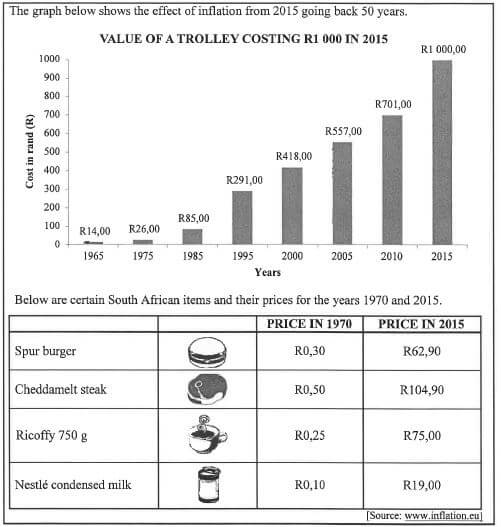
Use the information above to answer the questions that follow.
2.2.1 Explain the term inflation within the given context. (2)
2.2.2 Write down the price of a Spur burger in 1970. (2)
2.2.3 Calculate by how much the cost, in rand, of a trolley had increased from 2000 to 2005. (3)
2.2.4 Calculate the percentage increase of Ricoffy from 1970 to 2015. You may use the following formula:
- Percentage increase = new amount - original amount x 100 % (3)
original amount
2.2.5 A cheddamelt steak was sold for R104,90 at a percentage profit of 17,5%. Determine the cost price. (2)
2.3 TABLE 3 below shows the national budget and education budget of South Africa for 2017/18.
TABLE 3: NATIONAL BUDGET AND EDUCATION BUDGET OF SOUTH AFRICA FOR 2017/2018
| NATIONAL BUDGET OF SOUTH AFRICA (IN RAND) | EDUCATION BUDGET OF SOUTH AFRICA (IN RAND | ||
Economic affairs and agriculture | 241,6 billion | Basic education | 216,7 billion |
Defence and public safety | 198,7 billion | University subsidies | 31,6 billion |
Health | 187,5 billion | Education administration | 15,8 billion |
General admin | 70,7 billion | Skills development levy institutions | 21,1 billion |
Local development and infrastructure | 195,8 billion | National student financial aid scheme (NSFAS) | 15,3 billion |
Debt service costs | 162,4 billion | Technical and vocational education and training | 7,5 billion |
Socialprotection | 180,0 billion | Other | 12,5 billion |
| Education | 320,5 billion | ||
[Adapted from www.graphics24.com]
Use TABLE 3 above to answer the questions that follow.
2.3.1 Which of the amounts below represents the economic affairs and agriculture budgets?
- 24 160 000
- 241 600 000 000
- 241 600 000
- 24 160 000 000 000 (2)
2.3.2 Explain the term budget within the context above. (2)
2.3.3 Write down the item which receives the third most money from the education budget. (2)
2.3.4 Calculate the percentage of the total education budget that is allocated to the NSFAS. (3)
2.3.5 University subsidies comprise about 9,86% of the total education budget. Estimate the combined budget, as a percentage, for education administration and the NSFAS. (2) [41]
QUESTION 3
3.1 Liam and Amy are planning their wedding. Amy wants a four-layer red velvet wedding cake. She must still decide between a cylindrical or rectangular cake as shown on ANNEXURE B.
Use ANNEXURE B to answer the questions that follow.
3.1.1 Determine the total height of the cylindrical cake in millimetres.
3.1.2 The base (bottom) layer of the cylindrical cake has a radius of 14 cm.
- Determine the diameter of the base layer in cm.
- Calculate the volume (in cm3) of the base layer.
You may use the following formula:
- Volume of a cylinder = π x (radius)2 × height, and using π = 3,142 (3)
3.1.3 Define the term perimeter. (2)
3.1.4 Calculate the area (in cm2) of the base of the pan needed to bake the top layer of the rectangular cake.
You may use the following formula:
- Area = length x width (2)
3.2 Aunt Abby will bake the wedding cake. She will be using a recipe from a recipe book published in England.
NOTE:
- 1 kg = 2,25 pounds
- 1 ml flour = 0,7 g flour
3.2.1 Aunt Abby needs 3 and a half pounds of butter. Determine the mass of butter, in kilogram. (2)
3.2.2 Aunt Abby only has a kitchen scale available. If aunt Abby needs 625 ml, of flour, determine the mass of the flour in grams. (2)
3.2.3 The cake must be baked at 356 °F. Determine to what degree Celsius the oven should be turned. You may use the following formula:
- ºC = (ºF - 32º) ÷ 1,8 (2) [18]
QUESTION 4
4.1 A parkrun is a weekly 5 km run. A group of runners drove from Upington to Springbok to take part in the weekly parkrun in Springbok.
ANNEXURE C shows a route map from Upington to Springbok.
Use ANNEXURE C to answer the questions that follow.
4.1.1 Give the general direction from Upington to Springbok. (2)
4.1.2 Write down the name of the national park close to Kamieskroon. (2)
4.1.3 Name TWO towns the runners will pass through on their way to Springbok, following the N14. (3)
4.1.4 Identify the type of scale used on the map. (2)
4.1.5 Use the given scale to determine the actual distance (to the nearest km) between Upington and Springbok. (4)
4.2
| On arrival in Springbok the runners must first pick up Joe, a fellow runner, before heading to the parkrun (B). ANNEXURE C shows a street map indicating the route from entering Springbok (A) to the parkrun (B). |
Use ANNEXURE C to answer the questions that follow.
4.2.1 Name the road by which they will enter Springbok. (2)
4.2.2 Joe gives them the following directions to his home:
- Enter Springbok from Upington.
- Turn right into Uitspan Street.
- Turn left into Lukhof Street.
- Turn left into the first street.
Use the directions above to determine in which street Joe lives. (2)
4.2.3 Name of the lodge near the parkrun. (2)
4.2.4 The distance from Joe's house to the parkrun is 2,34 km. They travel at an average speed of 40 km/h. Determine how long it will take them (in minutes) to get from Joe's house to the parkrun.
You may use the following formula:
- Time = distance (3)
speed
4.2.5 29 of the 42 athletes who participated in the parkrun were female. Determine the probability of randomly selecting a male athlete from this group. (2) [24]
QUESTION 5
5.1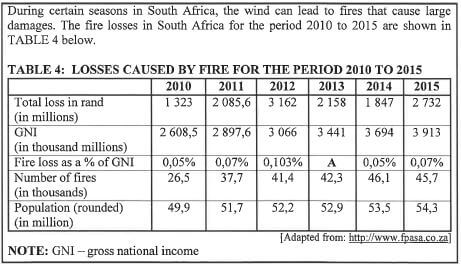
[Adapted from: http://www.fpasa.co.za]
Study TABLE 4 above to answer the questions that follow.
5.1.1 Write down the total loss, in rand, caused by fire during 2011. (2)
5.1.2 Calculate the mean total loss, in rand, caused by fires for the period 2010 to 2015. (3)
5.1.3 Identify the maximum number of fires for the period 2010 to 2015. (2)
5.1.4 Calculate the value of A, the fire loss as a percentage of the GNI for 2013. Round your answer to TWO decimal places. (4)
5.2 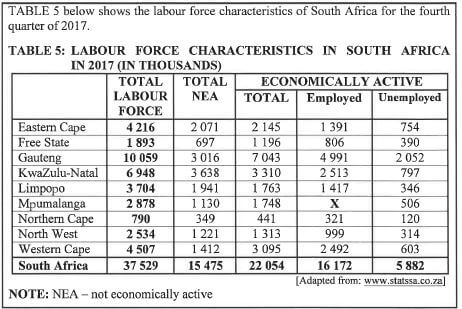
[Adapted from: www.statssa.co.za]
Use TABLE 5 above to answer the questions that follow.
5.2.1 Explain the meaning of the term unemployed within the context of the table above. (2)
5.2.2 Determine the value of X, the number of people employed in Mpumalanga. (2)
5.2.3 Name ONE data collection instrument that could be used to collect the data above. (2)
5.2.4 Calculate the percentage of people in the Western Cape who are NOT economically active (NEA). (3)
5.2.5 Write down the ratio of employed people to unemployed people in South Africa in the form ... : 1. (2)
5.2.6 Determine the probability (as a decimal) of randomly selecting a person in the Free State who is NOT economically active (NEA). (3)
5.2.7 The graph on the ANSWER SHEET represents the number of economically active people, as well as those who are not economically active (NEA) in South Africa. The bars for ALL economically active persons and only the bar for the people in the Eastern Cape who are NOT economically active (NEA) are drawn.
Use the ANSWER SHEET to draw the graphs for the rest of the provinces. (6)
5.2.8 Determine the probability, as a simplified fraction, of selecting a province where fewer than 350 000 people are unemployed. (4) [35]
TOTAL: 150
ANSWER SHEET
QUESTION 5.2.7
CENTRE NUMBER:
EXAMINATION NUMBER